For the average person, a government order to shelter in place or stay at home comes with some adjustments. Many changes are cerebral: we navigate vast expanses of togetherness with our families while figuring out how to balance work, life, and newfound teaching roles. Other changes are physical, like giving each other enough space to be successful. A lucky few can say that not much has changed for them personally. No matter what your position is in this thing, if you have a place to shelter, you’re doing better than 20% of the world’s population.
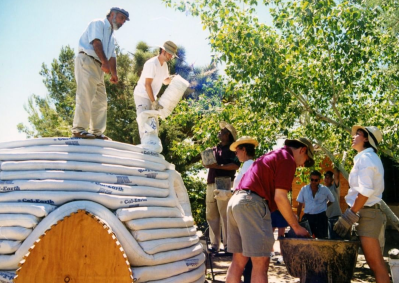
An estimated 1.6 billion people, including those who are homeless and those who are refugees, are living without adequate shelter. The need for shelter is a cornerstone of human well-being, and yet building a home for oneself can seem totally out of reach. After all, most people aren’t qualified to build a habitable structure without an architect, an engineer or two, and a team of construction workers with heavy equipment. Or are they?
It all depends on the design and materials. Dome structures have been around for centuries, and the idea of using packed earth to build walls is a tried and true concept. Architect Nader Khalili perfected a blend of the two concepts with his SuperAdobe construction system, which employs long sandbags filled with moistened earth. Khalili opened the California Institute of Earth Architecture (CalEarth) in 1991 to explore the possibilities of SuperAdobe and to educate others in the building process.
I grew up among the poor. I am one of nine children, and constantly knew need. I never forgot, so now I’m responding. — Nader Khalili
This year, the Hackaday Prize is teaming up with CalEarth to push their widely accessible concept of sustainable living into the future. As with our other three non-profits, this effort is twofold. The open call challenge invites you to design sustainable add-ons for SuperAdobe homes that expand their livability and are simple to build and use. Throughout June and July, our CalEarth Dream Team members are working to find ways to automate the process so that these homes can be built much faster, and in turn help more people.
SuperAdobe is Super Easy
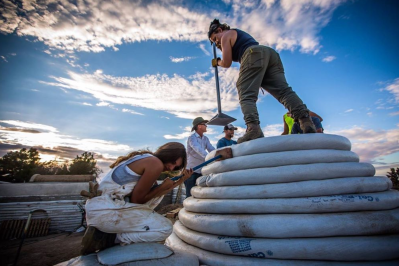 The SuperAdobe system is simple enough that people of all ages and backgrounds can start building as soon as they learn the methods and observe them in action.
The SuperAdobe system is simple enough that people of all ages and backgrounds can start building as soon as they learn the methods and observe them in action.
Essentially, long sandbags are filled in place, by hand, with moistened soil from the site. The soil is stabilized with lime, cement, or whatever is available. Then the bags are tamped down and spiraled into layers, with a course of barbed wire laid in between each one for stability.
It’s a laborious process for certain, but the result is a sustainable home that’s easy to heat and cool even in weather extremes, and can withstand natural disasters including seismic shocks. SuperAdobe structures are designed with the elements in mind, and are positioned to leverage natural light and guard from wind.
Sustainable Humanitarian Aid
CalEarth’s main focus is on providing a system to build affordable, sustainable homes for refugees, homeless, and other displaced persons. They have directly helped those affected by the 2010 earthquake in Haiti and other disasters by building shelters in a matter of days.
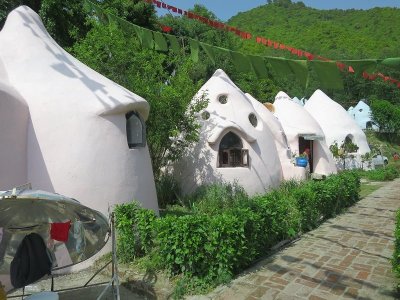
Many of CalEarth’s students take the idea and use it to start or further their own relief initiatives. In 2005, the Small Earth charity in the UK built 40+ domes in Kathmandu, Nepal, creating a hostel for children and their caretakers. Happily, all the domes survived a 7.6 magnitude earthquake in 2015.
The CalEarth Institute in Hesperia, California offers workshops and classes both in person and online for anyone who wants to go forth and build Earth-friendly homes for others or even for themselves. While the Institute itself is a wonderland of resources, the idea is to be able to build SuperAdobe structures anywhere they’re needed, using whatever materials are available.
Therefore, the ability to substitute and improvise is an important part of the plan. CalEarth have recently developed a duffel bag shelter system. Essentially, they wanted to be able to put someone on a plane with two duffel bags packed with enough tools and materials to build a six-foot emergency shelter anywhere in the world (PDF).
Design Sustainable Add-ons
One of CalEarth’s goals is to make these emergency shelters more livable in the long-term by integrating modern comforts that use sustainable technology. These would come in the form of modular add-ons that can be customized as needed.
Their main focus for these add-ons is on heating and cooling methods like the rocket mass heater and passive cooling system in the eco-dome shown above. They are also focused on finding thermal flooring solutions, new uses for solar panels, and ways of harvesting water. If you can think of a way to collect rainwater, filter it, and pump it through a solar-heated shower, you’re definitely on the right track.
Ideally, these add-ons would be modular and highly mobile to compliment the emergency shelter duffel bag system. Flat-pack design would be perfect. They should be easy to deliver around the world, and then to set up and use once they arrive. These problems need fresh eyes and creative thinkers who value simplicity and using natural resources wherever possible.
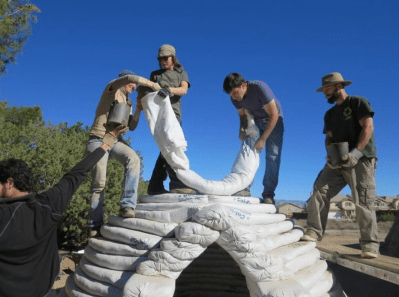 Help Automate the Process
Help Automate the Process
For the Dream Team challenge, the focus is on automation. The single most expensive aspect of building SuperAdobe structures is the time investment. Right now, it’s all manual labor, and the bags are filled by hand, one bucket or coffee can at a time.
The CalEarth Dream Team will be working to develop modular solutions to automate the process every step of the way. For example, finding a way to mechanically open the bags and keep them open as they’re filled so that the humans can focus on other things. Or how about a crank-powered machine that can fill the bags faster, or a collapsible tool that can tamp the bags in larger footprints? Maybe there’s a way to lay barbed wire automatically so no one has to worry about getting hurt.
Whatever you come up with, we want to see it. Watch the Q&A video with CalEarth directors Sheefteh and Dastan Khalili below to better understand the challenges of building and modernizing sustainable housing, and start your entry today!
All images courtesy of CalEarth.

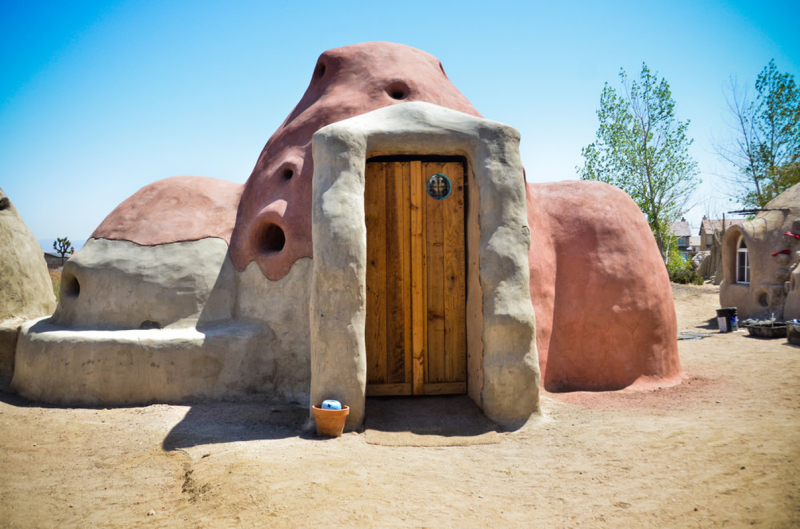



















These are basically over-sized sausages. Perhaps scaling up a sausage-making machine with an ingredient-bin designed to be loaded by a conventional skid-steer skip loader (think Bobcat S70 or similar). The machine would combine the ingredient bin contents with an appropriate amount of water and then extrude it into casings in a manner similar to the commercial manufacture of sausages, just bigger and heavier. It might even be possible to add a delivery system at the end a la 3D printer to feed the sausages (and possibly barbed wire) into position according to a preprogrammed design.
I was thinking mush the same thing.
If nothing else the idea of pulling a length of the skin over the nozzle of a funnel then controlling the rate at which it slides off as it fills seems like it should work. This is just plastic tube and a hopper and rammer, at its most basic level.
Convert a diaper genie LOL (Bags are a tube I think)
I think you guys are missing a key point here. These houses can be built BY HAND. No tech or machinery required. In the areas where they are most likely to be useful, are areas where getting plant machinery to would probably be quite hard. No to mention that you would need a skilled person qualified to operate and repair that machinery.
My suggestion wasn’t a machine, it was just a big funnel and a ramming stick. The only real twist to how they are already doing it is bunching up the tube on the outlet of a funnel like a sausage-making machine.
“No tech or machinery required” – excpet for, you know, the bags and the barbed wire.
I think these are going to be wanted where getting machinery on site is difficult, and if possible, fuel is going to be short. The only types of solutions I could think of just transformed the constructive exhausting physical labor required of many human participants, into mindless exhausting physical labor (Feed the machine slave! ) by only 0.95 as many. The major problem is just getting the amount of earth required fed up to the building level. Sure, scrape it up with front end loaders and dump it out of excavator buckets when there’s clear good roads in, machinery and fuel available, problem solved… but real world disaster scenario it’s gonna be all people, which means shovelwork, wheelbarrows, and heavy humping.
Exactly, folks are thinking from 1st world perspective but you have to think from 3rd world perspective. There is abundance of hands and not enough tools. My bet would be on something you clamp bags so they stay open and shovel dirt in. I was helping as boy scout during flood in 90ties in Poland and local blacksmith/welder/tinkerer used some spare steel and welded few frames then locals, we and military shoveled dirt in bags to build makeshift dam – heavy machinery was occupied elswhere, back breaking work but doable.
Getting that Bobcat into a duffel is going to win you some scars….
This entire comment reads like “how can I shoehorn all this fancy technology into a problem it doesnt help with”
This, I have been studying earthbag building for a few years now and there is something like this that is an attachment for the skid-steer and has a screw-drive in the bottom outputting to a pipe with the bag pulled over.
“Architect Nader Khalili perfected a blend of the two concepts with his SuperAdobe construction system, which employs long sandbags filled with moistened earth.”
Decades ago, adobe was also used in automobile construction!
https://www.nbc.com/saturday-night-live/video/adobe/n9492
And it’s within commuting distance of Mos Eisley.
“But I wanted to pick up some power converters!”
“You can waste time with your friends when your chores are done.”
These structures are a very inefficient use of space and this is particularly relevant in the context of housing large numbers of impoverished people. It is a shame that they were not able to apply knowledge of space filling curves to produce something with greater packing efficiency.
See: Pearce, Peter (1978). Structure in nature is a strategy for design. M.I.T. Press, Cambridge, Mass. ; London
ISBN: 978-0-262-16064-3
The above is out of print but can be found here, http://93.174.95.29/main/F9604B394A5FE36B1F8B04D90C3B3721
Whatever happened to rammed earth? The solution to the 3rd world housing problems of the 1980’s?
Do you mean like this? https://en.wikipedia.org/wiki/Earthship
Rammed earth used since early neolithic: https://en.wikipedia.org/wiki/Rammed_earth#History
There’s slightly more modern alternative method: https://en.wikipedia.org/wiki/Geopolymer
Dont forget the Lego Version, https://youtu.be/XY_5wkQRqEo?t=19
The machines arent that expensive NOR complicated https://youtu.be/kymyGR0wyBs
You can pick a manual press up for $1k USD if you dont want to weld one together from plans https://youtu.be/pm3-yQr1FnY
To my eye, this looks far too labor intenstive to attract much development work in already developed countries. I don’t think adding expensive equipment to the requirements would help the developing world adopt this system either. Something like a concrete tent https://youtu.be/Vb1pdvvoVoQ where you have a low pressure bladder system that you can cover with a permanent shell seems like it would draw more investment from diy’er Americans/Europeans, and have major spillover for less fortunate folk.
Rammed earth uses barely any equipment, let alone “expensive equipment’.
Is it really any more labor intensive than traditional construction? It doesn’t require any specialized tools or training. A shovel and a wheelbarrow is probably sufficient to build the majority of an energy efficient structure that would last decades.
There’s a family on YouTube that made one for each of their four kids. The entire family was involved. Each unit cost less than $5000 to make, taught them skills in construction, and self-sufficiency.
As for concrete, it’s expensive, not readily available in the 3rd world, and not terribly environmentally friendly.
Too bad this would be illegal in the parts of the USA where it is needed most.
Which parts are those? I’ve seen these built in both CA and AZ.
I am starting to become very disillusioned with the trend of Hackaday linking to a video with absolutely no details on what it contains or how long it is, or how much of it I have to sit through before anything interesting comes along.
I do often wonder if the writers actually watch some of the videos they link to at all!
I come to hackaday to see interesting things and *read* a little about things (which I can do in a few minutes) without having to wade through a half-hour video that is just like any other video on youtube (apart from perhaps the ‘deboxing’ videos…)
WTF.
Just click on the time bar to go to 10%, 20%, 30%, etc, and see if you see anything interesting.
That is true, except if something interesting happens at 15%…!
I expect ‘journalists’ (in this case the hackaday technical writers) to not necesarily pick things apart, but at least go into some detail and do the work I expect of them – even if it is just “skip the introduction and get right to the story at 5:10”. As it is I see a youtube video link and with no details on what or when, simply move to the next story. Those I invest my time in I watch at 1.25x, sometimes 1.5x, and on occasion 2x – only to discover that often it was not worth watching *at all*.
It regularly seems the hackaday witers are really scrabbling for a story. It used to be that the stories were well reseached and and well written, and there still are quite a lot of those, but they are *definately* becoming rarer.
The worst one I saw (and I’m pretty sure it was here on hackaday) amounted to approximately four lines of text with a link to a video.
First off, some of these are quite lovely looking. I wouldn’t necessarily be against living in one myself.
In the case where these are to be built in communities within non-developed countries, isn’t it ideal that, while labor-intensive, doesn’t require materials manufactured using costly infrastructure other than relatively cheap and transportable components like the bags and barbed wire? Able-bodied laborers where this is most needed is cheap and plentiful, unlike specialized construction machinery. It would seem to me that the best optimization would be in the logistics of getting the non-local materials and the skills training along with rallying the communities where these are to be deployed.
Able bodies laborers are available in a lot of places, but what is often lacking is a sense of community where people will work together to build a house for a neighbor.
Which I consider to be one of the challenges in “rallying the community”. Of course, no one should be forced to participate, but then they might not receive the materials and help needed to build their own home.
Its a grand gesture but most of the people who these groups keep trying to sell this “providing a system to build affordable, sustainable homes for refugees, homeless, and other displaced persons” to do not have land that they can build on permanently or often even permanent residency in a country or locale, they will move to where they can attain a better life or return to their homes to rebuild once the disaster is over. The reason relief agencies always go with tents is they know that they will be temporary. How about designing things that will make these peoples lives better and they can take with them as they move around looking for a better life.
Looks a little like Elder scrolls 3: Morrowind houses.
Check out the My Little Homestead series on building an earthbag home. https://www.youtube.com/user/mylittlehomestead
Wow this is great for all the people that own land but couldnt afford to put a building on it.
All 6 of them
1.6 billion people?
Stop lying
Define “adequate” as you like to reach your target number.
Anyone have any good ideas for providing waterproofing for these structures (especially the domes) in areas with high rainfall? It needs to be something which will allow the earth bags to breathe out, but not let the damp in from the outside.
Anyone have any good ideas for a fast, low-tech applicator for a UV-proofing, adobe-like plaster to be sprayed (or even hand-painted) onto the walls to prevent degradation of the bags before the finishing plaster is applied?
How about a “Tyrolean machine”
https://www.youtube.com/watch?v=Ry0MPEZZtJ4
For an example.
They can be had for $20 or so, but I doubt that one that cheap would last through a whole house.